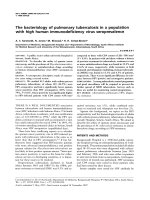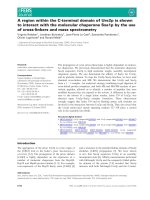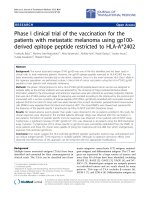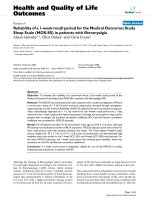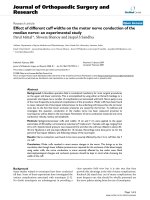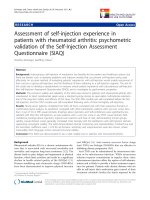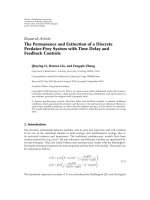Evaluate the optic nerve head of early open angle glaucoma patients with high myopia using heidelberg retinal tomography II
Bạn đang xem bản rút gọn của tài liệu. Xem và tải ngay bản đầy đủ của tài liệu tại đây (1.93 MB, 109 trang )
Evaluate the optic nerve head of early
open-angle glaucoma patients with
high myopia using Heidelberg Retinal
Tomography-II
Zheng Ce
(MB)
A THESIS SUBMITTED FOR THE DEGREE OF
MASTER OF SCIENCE
DEPARTMENT OF OPHTHALMOLOGY
MATIONAL UNIVERSITY OF SINGAPORE
2004
ACKNOWLEDGEMENT
First and foremost, I would like to express my deepest gratitude to my supervisors,
A/Professor Paul Chew Tec Kuan, for his considerate and patient guidance, valuable and
resourceful advice, and continuing and intensive support throughout the entire project. He
provided me an opportunity and helped me to learn and improve myself to be an
independent medical research scientist.
I would also like to acknowledge my gratitude to:
¾ My co-supervisors, Dr Wong Hon Tym and Dr David Garway-Heath, for their kindly
help, instruction and friendship;
¾ The reviewers of the previous edition, Dr Leonard Ang Pek Kiang and Dr Hoh Sek
Tian for their suggestions and contributions to the complement of my thesis;
¾ My dear friends, Xiao Tao and Hai Dong Lou, for their concern and encouragement;
Finally, I also wish to give special thanks to my beloved family, Mr. and Mrs. ChunYuan Zheng, Ms. Xian Zheng and my dearest wife Lina, for their limitless support and
endless love.
I
TABLE OF CONTENTS
ACKNOWLEDGEMENT………………………………………………………………..I
TABLE OF CONTENTS…………………………………….…………………………II
TABLE OF TABLES………………………………………………………………….VI
TABLE OF FIGURES………………………………………………………………VIII
List of Abbreviations……………………………………………………………….X
SUMMARY……………………………………….……………………………….…XI
CHAPTER 1 INTRODUCTION……………………………………………...……….1
1.1 Introduction to the Eye……………………………………………………1
1.2 Glaucoma………………………………………………………………………....4
1.2.1 Classification………………………………………………………………………………………4
1.2.2 Primary Open-angle Glaucoma (POAG)………………………………………………….6
1.2.2.1 Definition………………………………………………………………………6
1.2.2.2 Risk factors and association of POAG…… …………………………7
1.2.3 Clinical Diagnosis of Glaucoma…………………………………………………………8
1.3 Myopia…………………………………………………………………………..…8
1.3.1 Definition.………………………………………………………………………………………….8
1.3.2 Prevalence…………………………………………………………………………………………9
1.3.3 High myopia……………………………………………………………………………………10
1.3.4 The Optic Nerve Head in a Highly Myopic Glaucomatous Eye………………..11
1.4 Confocal Scanning Laser Ophthalmoscopy…………………………….12
II
1.4.1 Confocal Laser Scanning System……………………………………………………….13
1.4.2 Analysis of Topography Images of Optic Nerve Head……………………………17
1.4.2.1 Reference plane…………………………………………………………………..18
1.4.2.2 Optic Disc Measurement ………………………………………………………19
1.4.2.3 Using stereometric parameters to detect glaucoma………………….20
1.4.3 The limitation of Confocal Scanning Laser Ophthalmoscopy in High
Myopia……………………………………………………………………………………………………..21
1.5 Aim of Study……………………………………………………………………22
CHAPTER 2 MATERIALS AND SUBJECTS…………………………….………23
2.1 Subjects…………………………………………………………………….……23
2.1.1 Normal Subjects……………………………………………………………………….……..23
2.1.2 Early Open-angle Glaucoma Subjects………………………………………….……..23
2.2 Examinations………………………………………………………….…….…24
2.2.1 Visual Acuity……………………………………………………………………………….…..25
2.2.2 Refraction………………………………………………………………………………………..25
2.2.3 Slit lamp biomicroscopy……………………………………………………………………..26
2.2.4 Goldmann IOP test……………………………………………………………………………26
2.2.5 Gonioscopy……………………………………………………………………………………….27
2.2.6 Humphrey visual field test………………………………………………………………..29
2.2.7 Optic nerve head imaging…………………………………………………………………34
CHAPTER 3 RESULTS………………………………………………………………38
III
3.1 Comparison of HRT parameters between eyes with and without
high myopia………………………………………………………………………….38
3.1.1 Demographic Characteristics …………….………………………………………………38
3.1.2 Comparison of HRT Parameters………………………………………………………….41
3.1.3 New Proposed Parameters………………………………………………………………..47
3.2 Relationship among HRT parameters…………………………………..52
3.3 Clinical Diagnostic Ability of HRT-II…….……………………………59
3.3.1 Clinical diagnostic ability of HRT-II to differentiate high myopic ONH from non-high
myopic ONH…………………………………………………………………………….59
CHAPTER 4 DISCUSSION…………………………………….…………………..62
4.1 Optic Nerve Head Morphology in High Myopic Early Open-Angle
Glaucoma……………………………………………………………………………..62
4.1.1 The ONH in highly myopic patients is more tilted than that in non-highly myopic
patients………………………………………………………..……………………………….63
4.1.2 The Optic Nerve Head cupping in Highly Myopic Patients with Early Open Angle
Glaucoma……………….……………………………………………………………………….68
4.2 How Does Optic Nerve Head Tilt in Highly Myopic Patients
Influence the HRT-II Parameters? ..........……………………………………70
4.2.1 The TV1 has significant positive correlations with following HRT parameters:
reference height, rim volume, high variation contour and retinal nerve fiber layer
thickness…………………………………………………………………………………………………71
4.2.1.1 Reference height………………………………………………….………………71
4.2.1.2 Rim volume…………………………………………………………………………74
IV
4.2.1.3 Retinal nerve fiber layer thickness…………………………………………75
4.2.2 The TV2 has significant negative correlation with following HRT’s parameters: disc
area, cup area, cup/disc area and cup volume……………………75
4.2.2.1 Disc area…………………………………………………………………………….75
4.2.2.2 Cup area, cup/disc ratio and cup volume…………………………….80
4.3 The Diagnostic Ability of HRT…………………………………………….80
4.4 Conclusion………………………………………………………………………84
4.5 Future Work……………………………………………………………………84
Reference…………………………………………………………………………….86
V
Table of Tables
Table 2.1 Age-related plus-power in this study…………………………………………….29
Table 2.2 Description of HRT topographic parameters…………………………………35
Table 3.1 Distribution of 4 subjects groups………………………………………………….38
Table 3.2 Demographic characteristics of normal subjects…………………………..…39
Table 3.3 Demographic characteristics of glaucoma subjects……………………..….40
Table 3.4 Comparison of HRT parameters in normal subjects with and without
high myopia………………………………….………………………………………………………….42
Table 3.5 Comparison of HRT Parameters in Glaucoma Subjects with and without
high myopia…………………………………….……………………………………………………….43
Table 3.6 Comparison of HRT parameters in non-highly myopia subjects with &
without early glaucoma………………………………..…………………………………………….45
Table 3.7 Comparison of HRT parameters in highly myopia subjects with &
without early glaucoma………………………….…………………………………………………..46
Table 3.8 Comparison of Tilt Values in Normal Subjects, With & Without High
Myopia...................................................................................................…...50
Table 3.9 Comparison of Tilted value between Eyes with High Myopia and nonhigh Myopia in Glaucoma subjects……………………………………………………………..50
Table 3.10 Comparison of Tilt Values in Non-highly myopic Subjects, Normal &
Early glaucoma………………………………………………………………………………………….51
Table 3.11 Comparison of Tilt Values in Non-highly myopic Subjects, Normal &
Early glaucoma……………………………………………………………………………….…………51
VI
Table 3.12 Relationship between HRT parameters in the normal nonglaucomatous group………………………………………………………………………………….53
Table 3.13: Relationship between Age and TVs in the normal non-glaucomatous
group……………………………………………………………………………………………………….53
Table 3.14 Relationships between HRT parameters in the glaucoma group……..56
Table 3.15 Specificity, sensitivity, and diagnostic precision of HRT-II……………60
Table 3.16 Area under the ROC curve……………………………………………………….61
Table 4.1 the sensitivity and specificity in other study…………………………………65
VII
Table of Figures
Figure 1.1 Section diagram of the eye…………………………………………………..………1
Figure 1.2 Visual perception…………………………………………………………………..…….3
Figure 1.3 View of normal vision vs. glaucoma………………………………….……………4
Figure 1.4 Mechanism of myopia……………………………………………………...............8
Figure 1.5 Myopic retinopathy (from Duane’s Ophthalmology)…………………….…10
Figure 1.6 Highly myopic optic nerve head of glaucomatous eye….………………11
Figure 1.7 Heidelberg Retina Tomography-II (HRT-II)…………………………………..12
Figure 1.8 Confocal laser scanning system……………………………………………………13
Figure 1.9 A layer-by-layer three-dimensional image…………………………………....14
Figure 1.10 Color scale in HRT………………………………………………………………..….15
Figure 1.11 Reference plane……………………………………………………………………….17
Figure 1.12 Papillo-macular bundle……………………………………………………………..18
Figure 1.13 Sector of neuro-retinal rim used to define the retinal surface
height………………………………………………………………………………………..19
Figure 1.14 Optic disc measurements……………………………………………….………..19
Figure 2.1 LogMAR chart……………………………………………………………………………23
Figure 2.2 Slit lamp biomicroscopy……………………………………………………………..24
Figure 2.3 Diagrammatic representation of angle grading…………………………….26
Figure 2.4 Humphrey® Field Analyzer…………………………………………………………27
Figure 2.5 drawing the contour line……………………………………………………….……31
Figure 2.6 Sample of HRT-II parameters……………………………………………………36
Figure 3.1 tilt value…………..……………………………………………………………………..47
Figure 3.2 tilt value in different direction………..………………………………………….49
Figure 3.3 Plot of rim/disc area ratio vs. tilted value 1…………………………………..55
Figure 3.4 Plot of mean cup depth in temporal side against tilted value 1……….55
Figure 3.5 Plot of cup/disc area ratio vs. TV 1……………………….………………….58
Figure 3.6 Plot of reference height vs. TV 1……………….……………………………..58
VIII
Figure 3.7 ROC (receiver operated characteristic) curves………………………………60
Figure 4.1 A reference ring in HRT……………….……………………………..………………65
Figure 4.2 Reference height………………………………………………………………………73
Figure 4.3 Disc area.…………………………………………………………………………….77
Figure 4.4 Optic nerve head in without highly myopic eye…………………………………..78
Figure 4.5 Optic nerve head in highly myopic eye………….…………………………………78
Figure 4.6 the disc area on the reference plane………………………………………………………79
IX
List of Abbreviations
ONH……………………………………..…………………………………………..Optic Nerve Head
HRT…………………………………………………………………Heidelberg Retinal Topography
PPA…………………………………………………….…………..…………Peri-papillary atrophy
C/D ratio………………………………………………………………………………….cup/disc ratio
TV…………………………………………………………………………………………………..tilt value
POAG……………………………………………………….……….Primary open angle glaucoma
X
SUMMARY
The glaucoma is a diverse group of disorders that damage the optic nerve, resulting in
characteristic optic nerve head cupping and visual field loss. It is the leading cause of
blindness in the world. The WHO has estimated that worldwide blindness caused by
glaucoma amounted to 5.2 million cases. It is going to increase in importance in this
century. Although we have make a great improvement in the past few years, so far the
vision lost to glaucoma is permanent, unlike cataract and other leading cause of world
blindness. Hence, the only way to prevent blindness from glaucoma is to preserve vision
by early detection and treatment.
Myopia is a rapidly worsening public health problem in East Asia. Surveys have indicated
that myopia afflicts 25% of 7 year olds, 33% of 9 year olds, 50% of 12 year olds and
more than 80% of 18 year old males in Singapore. Other reports also showed that Japan,
Chinese’s mainland and Singapore have the highest prevalence in the world. Now, we
know myopia is associated with an increased incidence of primary open angle glaucoma
and myopic eyes are also more susceptible to the glaucomatous damage. Myopic
subjects had a twofold to threefold increased risk of glaucoma compared with that of
non-myopic subjects. On the other hand, due to the different morphology of optic nerve
head (ONH) in highly myopic eyes, it is difficult to differeniate the highly myopic ONH
with early glaucomatous damage from the ONH without glaucomatous damage.
Several methods have been used to evaluate the ONH. They include: ophthalmoscopy,
stereophotography, optic nerve head morphometry, nerve fiber layer analysis and so on.
Recently, the confocal laser scanning ophthalmoscope has been developed for objective,
XI
three-dimensional assessments of ocular tissues, such as the retina and optic disc. The
HRT generates a large number of measurement parameters. Several authors have
looked at these parameters in detail to determine which are of use to distinguish
between normal and glaucomatous optic discs. Various approaches to data analysis have
been taken and reached different result. Anyway, these results demonstrate that the
HRT is able to differentiate between normal and obviously glaucomatous eyes with a
high degree of accuracy.
Although HRT has some advantages, a lot of previous studies also demonstrated that
diagnostic ability of HRT has achieved a level of sensitivity and specificity that is suitable
for clinic use. However, in high myopic patients, because of the different shape of optic
nerve head, the diagnostic precision of HRT-II is very low in the same context.
To improve the clinical value of HRT-II in high myopia, data was collected on evaluate
the morphology of optic nerve head (ONH) in highly myopic eyes using the standard
software of HRT-II. The significant difference of disc morphology has been found
between the normal and glaucomatous optic nerve heads. Individual disc sector damage
also occurs more early and severely in early open angle glaucoma patients with high
myopia.
On the other hand, our study also showed that some of the HRT-II’s parameters were
erroneously estimated in highly myopic ONH. Disc area, cup area, cup/disc ratio and cup
volume were under-estimated, whilst other parameters such as: rim volume, retinal fiber
layer thickness and reference height, were over-estimated.
XII
To overcome these problems, a set of new parameters were introduced in this study.
We calculated the slope gradient of optic disc and found that there is significant tilting in
highly myopic discs with and without early open-angle glaucoma. This tilt inclined from
the nasal to temporal side. This is in agreement with what we can often see in clinic. By
evaluating the relationships between the slope gradient and the HRT-II parameters, we
found that the disc tilt has a significant influence with nearly all of the HRT parameters,
including the disc area, cup area, rim area, cup volume, rim volume est., thereby leading
to measurement error.
Due to the significant difference in morphology between non-highly myopic ONH and
highly myopic ONH, it is difficult for the standard protocol to differentiate the
glaucomatous ONHs from normal ONHs in all condition. Based on discriminant analysis
function, two formulas were separately developed for not highly myopic ONHs and
highly myopic ONHs. We compared the sensitivity, specificity and diagnostic value of our
method with standard method and found that new method produced better result than
previous method, especially in highly myopic eyes.
In conclusion, the method we have developed in this study has the potential to be used
as a reliable diagnostic adjunct for glaucomatous patients with high myopia.
Furthermore, we can incorporate some new parameters and formulas into HRT-II’s
software to improve its diagnostic precision when we use it to scan highly myopic
patients.
XIII
Chapter 1 Introduction
Chapter 1 Introduction
1.1
Introduction to the Eye
The eye is an important organ in the human body. It helps us to perceive the visual
world as a result of the transmission of a sequence of signals from the eye to the
brain. Understanding the normal function of the eye enables us to identify where,
and how, the eye fails in disease states.
Figure 1.1 Section diagram of the eye
When light rays enter the eye through the transparent cornea, the lens focuses the
image of the world outside on light-sensitive elements (the photoreceptors - rods for
1
Chapter 1 Introduction
night vision and cones for daylight and colour vision) at the back of the eye. These
connect to other nerve cells at the back of the eye in a delicate and thin structure
called the retina. The retina is the innermost of the three coats of the eye. This layer
is in the image plane of the eye’s optic system and is responsible for converting
relevant information from the image of the external environment into neural impulse
that are transmitted to the brain for decoding and analysis. The information is sent
to the brain in a large bundle of nerve fibers leaving the back of the eye. They leave
at the optic disk and form the optic nerve.
The fibers in the optic nerve pass to the brain where they connect in a special
structure called the lateral geniculate nucleus which in turn sends connections to the
visual cortex. Once in the cortex the visual information is processed in parallel
through many cortical areas each specializing in particular aspects of the visual world.
Through many complex connections between the different visual cortical areas our
perception of the visual world is integrated into the image we see in our mind's eye.
2
Chapter 1 Introduction
Figure 1.2 Visual perception
A special aspect to emphasize about the visual process is that many things happen in
parallel and that separate channels of output from the retina carry different types of
information about the visual world. These may be differentially affected by disease
processes. One channel (the magnocellular pathway) carries information especially
important to the processing of visual motion and another (the parvocellular pathway)
carries information that underpins color vision and the fine resolution of form.
Even a minor error that occurs on any component of the eye can damage its
structure and result in vision impairment.
3
Chapter 1 Introduction
1.2
Glaucoma
The term glaucoma covers a diverse group of disorders that damage the optic nerve,
resulting in characteristic ONH cupping and visual field loss. It is the leading cause of
blindness in the world [3]. It is responsible for 80,000 of the 500,000 legally blind
people in the US [1]. The worldwide incidence of glaucoma has been estimated by
various authors as between 0.47% and 8%
[2]
. The WHO has estimated that
worldwide blindness caused by glaucoma amounted to 5.2 million cases
[4]
. It is
going to increase in importance this century. Although we have made great
improvements in recent years, so far the vision lost to glaucoma continues to be
irreversible, unlike cataract and other leading causes of world blindness.
Figure 1.3 View of normal vision vs. glaucoma
1.2.1
Classification
The glaucomas are a group of potentially blinding ocular conditions. Because the
pathology, physiology, clinical presentation and treatment of the different types of
4
Chapter 1 Introduction
glaucoma are so varied, there is no single definition that adequately encompasses all
forms. The classification that follows is from “Becker-Shaffer’s Diagnosis and Therapy
of the Glaucomas”. This classification is not meant to be all-inclusive, but to be an
aid in thinking about pathogenesis and treatment
[5]
.
I. Angle-closure glaucoma
A. With pupillary block
1. Primary angle-closure with pupillary block
2. Secondary angle- closure with pupillary block
B. Without pupillary block
1. Primary angle-closure without pupillary block
2.
Secondary angle- closure with pupillary block
II. Open-angle glaucoma
A. Primary open-angle glaucoma
1. IOPs higher than “normal range”
2. IOPs within “normal range” (normal tension glaucoma)
B. Secondary open-angle glaucoma
III. Combined-mechanism glaucoma
A. Open-angle glaucoma complicated by angle-closure glaucoma
B. Mixed-mechanism angle-closure glaucoma with trabecular damage
5
Chapter 1 Introduction
IV. Developmental glaucoma
A. Primary congenital glaucoma
B. Secondary glaucoma
1.2.2 Primary Open-Angle Glaucoma
1.2.2.1 Definition
Primary open-angle glaucoma (POAG) is a generally bilateral although not necessarily
a symmetrical disease, characterised by the following
[6]
:
1. Adult onset.
2. An IOP>21mmHg at some point in the course of the disease.
3. An open angle of normal appearance.
4. Glaucomatous optic nerve head (ONH) damage.
5. Visual field loss
Despite this definition it should be emphasized that approximately 16% of all
patients with otherwise characteristic POAG will have IOPs consistently < 22mmHg
and constitute a sub-group referred to as “normal-tension glaucoma”
[8, 9, 10]
. POAG is
the most prevalent of all glaucomas, affecting approximately 1 in 100 of the general
population over the age of 40 years [11, 12].
6
Chapter 1 Introduction
ONH changes are the hallmark of glaucomatous damage. Its development is
associated with loss of tissue in neuroretinal rim of the ONH and a consequent
increase in the size of the optic cup. Glaucomatous cupping consists of backward
bowing of the lamina cribrosa, elongation of the laminar beams, and loss of the
ganglion cell axons in the rim of neural tissue
[85]
. The spectrum of disc damage in
glaucoma ranges from highly localized tissue loss with notching of the neuroretinal
rim to diffuse concentric enlargement of the cup. Because glaucomatous ONH
changing can occur before the visual field lost, it is important for ophthalmologist to
describe these changes when they assess the suspected glaucomatous patients.
1.2.2.2 Risk factors and association of POAG
1. Age: POAG is more common in older individuals and most cases present after the
age of 65 years
[6]
.
2. Race: POAG is significantly more common, develops at an earlier age, and is
more severe in blacks than in whites
[6]
.
3. Family history and inheritance: POAG is frequently inherited, probably in a
multifactorial manner. The responsible gene is thought to show a lack of
penetrance and a variation in expressivity in some families. The level of IOP,
facility of outflow and optic disc size are also genetically determined. First-degree
relatives of patients with POAG are at increased risk of developing the disease
[6]
.
4. Myopia is associated with an increased incidence of POAG and myopic eyes are
7
Chapter 1 Introduction
also more susceptible to glaucomatous damage
[6]
.
1.2.3 Clinical Diagnosis of Glaucoma
In the broadest terms, glaucoma involves a study of the following
[6]
:
1. Intraocular Pressure (IOP)
2. Optic nerve head damage
3. Visual field loss
4. Drainage angle
1.3 Myopia
1.3.1 Definition
Myopia is defined as that optical condition of the non-accommodating eye in which
parallel rays of light entering the eye are brought to a focus anterior to the retina
[7]
.
It can also be described as the condition in which the far point of focus is located at
some finite distance from the cornea. It is also called nearsightedness. The degree of
myopia is quantified in Dioptres (D) and is annotated with a minus sign by
convention.
8
Chapter 1 Introduction
Figure 1.4 Mechanism of myopia
Now, we know myopia is associated with an increased incidence of primary open
angle glaucoma and myopic eyes are also more susceptible to the glaucomatous
damage. Myopic subjects had a twofold to threefold increased risk of glaucoma
compared with that of non-myopic subjects
[8, 13, 14, 15]
. The risk was independent of
other glaucoma risk factors and intraocular pressure.
1.3.2 PREVALENCE
Stenstom's study in Uppsala, Sweden, consisted of clinic patients, colleagues, nurses,
and cadet officers, which is a group more reflective of the general population. His
study showed that about 29% of the population have low myopia (-2D), 7% have
moderate myopia (-2-6D), and another 2.5% have high myopia (>-6D)
[16]
. Japan,
Chinese’s mainland and Singapore have the highest prevalence in the world
9
[17,18,19]
.
Chapter 1 Introduction
Now myopia is a rapidly worsening public health problem in Singapore. Surveys have
indicated that myopia afflicts 25% of 7 year olds, 33% of 9 year olds, 50% of 12
year olds and more than 80% of 18 year old males in Singapore[19.22].
1.3.3 High myopia
Low or moderate myopia is generally associated with normal fundus findings.
Pathologic myopia, in which increased axial length and a history of progression
occurs, is associated with secondary macular and peripheral changes. The retina
appears thinned because of the enlarged eye. In addition, a localized posterior
scleral thinning (staphyloma formation) can occur, which increases the axial length
still farther. Bruch's membrane shows discontinuities, called lacquer cracks, which
may lead to subretinal neovascularization.
Figure 1.5 Myopic retinopathy (from Duane’s Ophthalmology)
The retina posteriorly near the optic disc is stretched and thin. The retinal pigment
10
Chapter 1 Introduction
epithelium and outer retinal layers is degenerated (arrow). In highly myopic eyes,
the ONH is significantly more oval and elongated in configuration and more obliquely
oriented than in any other group (figure 1.6).
Figure 1.6 The ONH appears oblique with increasing axial length
1.3.4 The Optic Nerve Head in a Highly Myopic Glaucomatous Eye
It has been proposed that myopic patients with typical tilt disks who develop
glaucoma may represent a distinct group of glaucoma patients who develop a
characteristic, myopic glaucomatous optic disc appearance
[23, 24]
. Disks of this type
are tilted (obliquely implanted) with a shallow appearance, have a myopic temporal
crescent of peri-papillary atrophy (as with non glaucomatous myopic optic disks),
and show additional evidence of glaucomatous damage, usually in the form of
thinning of the superior and/or inferior neuroretinal rim in the absence of
degenerative myopia.
11
